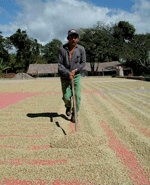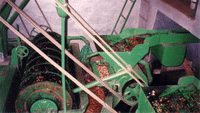
Before shipment, coffee is dried and a coffee moisture meter is used to measure coffee bean moisture. Coffee must be dried from approximately 60% moisture content to 11-12% moisture content.


Dry process, also known as unwashed or natural coffee, is the oldest method of processing coffee. The entire cherry after harvest is placed in the sun to dry on tables or in thin layers on patios. It will take between ten days and two weeks for the cherries to completely dry. The cherries need to be raked regularly to prevent mildew while they dry. Once the skin is dry, the pulp and parchment are removed from the bean. While coffee was once all dry processed it is now limited to regions where water or infrastructure for machinery is scarce. The supply of dry processed coffee is very limited, with coffee from the Harrar region of Ethiopia and some areas of Yemen and Brazil being the primary sources.

Most of the world's green coffee has gone through some sort of wet processing including most of the premium coffee. Any wet processing of coffee produces coffee wastewater which can be a pollutant. About 130 liters of fresh water is used in order to process one kilogramm of quality coffee. After the Green coffee is picked the coffee is sorted by immersion in water. Bad or unripe fruit will float and the good ripe fruit will sink. The skin of the cherry and some of the pulp is removed by pressing the fruit by machine in water through a screen. The bean will still have a significant amount of the pulp clinging to it that needs to be removed.

In the ferment and wash method of wet processing the remainder of the pulp is removed by breaking down the cellulose by fermenting the beans with microbes for several days and then washing them with large amounts of water. Fermentation can be done with extra water or in "Dry Fermentation" in the fruit's own juices only. In machine-assisted wet processing fermentation is not used to separate the bean from the remainder of the pulp rather it is scrubbed off by a machine.
After the pulp has been removed what is left is the bean surrounded by two additional layers, the silver skin and the parchment. The beans must be dried to a water content of about 10% before they are stable. Coffee beans can be dried in the sun or by machine but in most cases it is dried in the sun to 12-13% moisture and brought down to 10% by machine. Drying entirely by machine is normally only done where space is at a premium or the humidity is too high for the beans to dry before mildewing. When dried in the sun coffee is most often spread out in rows on large patios where it needs to be raked every six hours to promote even drying and prevent the growth of mildew. Some coffee is dried on large raised tables where the coffee is turned by hand. Drying coffee this way has the advantage of allowing air to circulate better around the beans promoting more even drying but increases cost and labor significantly. The parchment is removed from the bean and what remains is green coffee.

Semi dry is a hybrid process in very limited use in Brazil and Sumatara/Sulawesi. The cherry is passed through a screen to remove the skin and some of the pulp like in the wet process but result is dried in the sun and not fermented or scrubbed.
Information Source: Wikipedia and Image Source: Coffee Research
Flavor Characteristics of Drying Process | Sorting
Polishing and Aging | Roasting | Cupping | Decaffeination Processes


















































